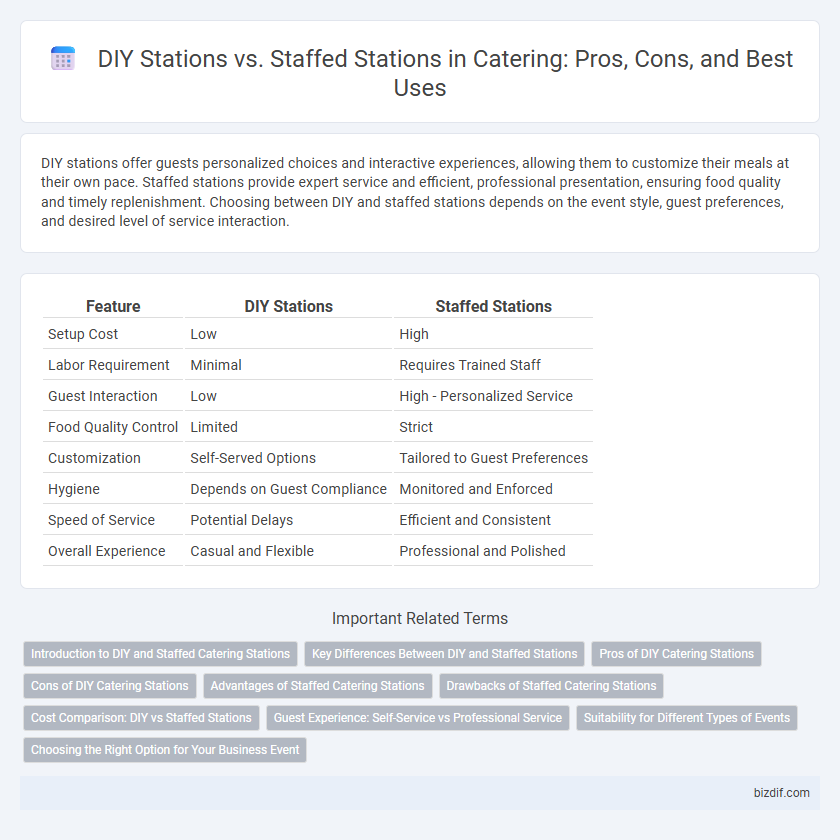DIY stations offer guests personalized choices and interactive experiences, allowing them to customize their meals at their own pace. Staffed stations provide expert service and efficient, professional presentation, ensuring food quality and timely replenishment. Choosing between DIY and staffed stations depends on the event style, guest preferences, and desired level of service interaction.
Table of Comparison
| Feature | DIY Stations | Staffed Stations |
|---|---|---|
| Setup Cost | Low | High |
| Labor Requirement | Minimal | Requires Trained Staff |
| Guest Interaction | Low | High - Personalized Service |
| Food Quality Control | Limited | Strict |
| Customization | Self-Served Options | Tailored to Guest Preferences |
| Hygiene | Depends on Guest Compliance | Monitored and Enforced |
| Speed of Service | Potential Delays | Efficient and Consistent |
| Overall Experience | Casual and Flexible | Professional and Polished |
Introduction to DIY and Staffed Catering Stations
DIY catering stations empower guests to customize their meals, enhancing engagement and accommodating diverse dietary preferences with a hands-on experience. Staffed catering stations offer personalized service with professional attendants who ensure efficient food presentation, portion control, and adherence to hygiene standards. Combining both options can balance interactive guest participation with expert assistance, optimizing overall event catering.
Key Differences Between DIY and Staffed Stations
DIY catering stations offer guests the freedom to customize their meals, enhancing engagement and accommodating diverse dietary preferences without requiring additional staff. Staffed stations provide expert service, ensuring precise preparation, maintaining food safety standards, and delivering a polished presentation that elevates the overall dining experience. Key differences include cost efficiency for DIY setups versus enhanced professionalism and quality control found in staffed catering stations.
Pros of DIY Catering Stations
DIY catering stations offer enhanced customization, allowing guests to select ingredients and portions according to their preferences, leading to higher satisfaction and reduced food waste. These setups often lower labor costs by minimizing the need for dedicated staff, enabling more flexible event budgeting. Moreover, DIY stations encourage interactive dining experiences, making events more engaging and enjoyable for attendees.
Cons of DIY Catering Stations
DIY catering stations often lead to inconsistent food quality and presentation, as guests serve themselves without professional assistance. These stations can cause longer wait times and congestion, diminishing the overall event experience. Lack of staff oversight may also result in increased food waste and hygiene concerns, impacting guest satisfaction and safety.
Advantages of Staffed Catering Stations
Staffed catering stations provide personalized service that enhances guest experience through real-time customization and efficient handling of dietary preferences. Trained staff ensure food safety and presentation consistency, elevating the overall event quality. These stations also streamline workflow, reducing wait times and allowing guests to enjoy freshly prepared dishes tailored to their tastes.
Drawbacks of Staffed Catering Stations
Staffed catering stations often involve higher labor costs and require careful coordination to manage personnel effectively throughout events. Dependence on staff can lead to slower service during peak times, reducing guest satisfaction and increasing wait times. Additionally, limited staff availability may restrict menu customization and flexibility compared to DIY stations, impacting the overall guest experience.
Cost Comparison: DIY vs Staffed Stations
DIY catering stations typically reduce labor costs by allowing guests to serve themselves, minimizing the need for catering staff and lowering overall expenses. Staffed stations incur higher costs due to wages, training, and tip considerations but often provide enhanced guest experience through personalized service. Businesses must weigh cost savings of DIY setups against the premium of staffed stations to align with event budget and service expectations.
Guest Experience: Self-Service vs Professional Service
DIY catering stations offer guests personalized control over their meal choices, fostering an interactive and flexible dining experience that appeals to diverse preferences and dietary needs. Staffed stations deliver expert service with skilled professionals who ensure food quality, presentation, and timely assistance, enhancing guests' comfort and satisfaction. Both options influence the overall guest experience, with DIY emphasizing autonomy and engagement, while staffed stations provide a polished and seamless service environment.
Suitability for Different Types of Events
DIY catering stations suit casual events like birthday parties or informal gatherings where guests enjoy customizing their own meals. Staffed stations are ideal for formal occasions such as weddings or corporate events, providing professional service and ensuring smooth flow. Event size also influences choice, with DIY favored for smaller groups and staffed stations better managing larger crowds.
Choosing the Right Option for Your Business Event
DIY catering stations allow guests to customize their meals, reducing labor costs and encouraging interaction, ideal for informal business events focused on networking. Staffed stations provide professional service and ensure food quality, making them suitable for formal corporate gatherings where presentation and efficiency are priorities. Evaluating guest preferences, event format, and budget helps determine whether DIY or staffed stations best enhance your business event experience.
DIY stations vs Staffed stations Infographic

 bizdif.com
bizdif.com